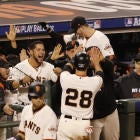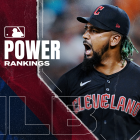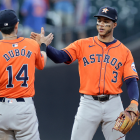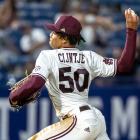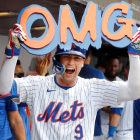The San Francisco Giants aren't ready to go home just yet.
Monday night at AT&T Park, the Giants stunned the Chicago Cubs twice in Game 3 of the NLDS. First Conor Gillaspie gave San Francisco a lead in the eighth inning, then after the Cubs tied it on Kris Bryant's ninth inning homer, Joe Panik won it with a walk-off double in the 13th inning (SF 6, CHC 5).
The Cubs still lead the best-of-five series 2-1, though they were five outs away from punching their ticket to the NLCS on Monday. They'll have to try again in Game 4 on Tuesday.
Now for some things to know about Game 3 ...
1. The win expectancy chart says it all about Game 3.
The win expectancy chart tracks each team's chances of winning a given game, and as you might expect the graph for Game 3 between the Cubs in Giants made for a veritable mountain range in the late innings ...
Source: FanGraphs
Madness. At one point, the Giants' chances of winning were down to 13.0 percent. They of course wound up winning. At another point, the Cubs were down to a 2.9 percent chance of winning, and the Kris Bryant home run ...
#KrisBryantAfterDarkpic.twitter.com/Hi7s4jumvJ
— Chicago Cubs (@Cubs) October 11, 2016
... brought them even on the scoreboard. At one point in the 13th, the Cubs' chances of winning reached almost 60 percent, but in the end it was the Giants who managed to survive all the ebbs and flows of this one. What a game.
2. The Giants haven't lost an elimination game in a long time.
The Game 3 win over the Cubs marked the 10th straight time the Giants have won a postseason elimination game. The last time they lost one? That was way back yonder in 2003, when they lost Game 4 of the NLDS to the Marlins. If the Giants manage to run this elimination game streak to 12 then they'll advance to the NLCS.
3. Not bunting paid off for the Giants in the 13th.
Brandon Crawford notched a leadoff double in the 13th, and led many of us to assume that Joe Panik would lay down a sac bunt opposite left-hander Mike Montgomery. Panik's a skilled bunter, and he ceded the platoon advantage to Montgomery. It made a certain sense. Giants manager Bruce Bochy let it ride, though, and this ensued ...
Sometimes it pays to let hitters hit and not squander precious outs.
4. The Cubs were in uncharted postseason territory.
Game 3 sprawled five hours and four minutes. In terms of innings, there's also this from the Cubs' standpoint ...
This is the longest game by innings in @Cubs postseason history.
— Baseball Tonight (@BBTN) October 11, 2016
They previously had 2 World Series games that went 12 (in 1907 and 1945).
Thirteen innings presumably feels a lot longer than 13 innings when you come up short.
5. The Giants' bullpen blew another save, but overall did a solid job.
The San Fran bullpen of course squandered a slew of ninth-inning leads in September, and during the regular season as a whole they led the majors with 32 blown saves. On Monday night, Sergio Romo of course coughed up the ninth-inning home run to Kris Bryant, and that old narrative was dragged howling from the vaults. Consider, though, the bullpen's overall work in Game 3: 8.0 IP,3 H, 2 R. That's solid work under, to say the least, high-pressure circumstances.
6. The Giants' eighth-inning comeback was improbable on multiple levels.
Coming into the eighth inning of Game 3, the Giants, per Ken Rosenthal, had not managed to score a run off the Cubs' bullpen all season. That's a span that covered 32 ⅓ innings. That obviously changed in a big way with Gillaspie's triple. Speaking of which ...
Gillaspie had never seen a pitch over 100 mph in his MLB career (1,467 PAs) until his Triple vs Chapman tonight (101 mph). #Giants#BeliEVEN
— Inside Edge (@InsideEdgeScout) October 11, 2016
Gillaspie's was also the first triple Chapman has ever allowed to left-handed batter. That's a lot of unlikely happenings occurring in quick succession.
7. Madison Bumgarner had never given up a home run to a pitcher before Monday night.
Yep. Bumgarner's given up 131 home runs in the regular season, and, coming into Game 3, another seven in postseason play. None had been to a pitcher until Arrieta's second-inning blast, when left the bat at 106 mph.
As for the other end of things, Arrieta's indeed capable of running into one on occasion. He's homered twice in each of the last two regular seasons, so counting his Game 3 blast that's five home runs in his last 150 at-bats dating back to the start of 2015 (and including his five ABs in the 2015 playoffs). Speaking of that Arrieta homer, it feels like it happened a week ago.
8. The Cubs made Madison Bumgarner work hard before the Arrieta home run.
You can't truly decouple any one event in baseball from that which came before it, and that's probably the case with Arrieta's homer. He'd already thrown 24 pitches in the second when Arrieta came to the plate (especially key was Javier Baez's 9-pitch at-bat that ended in a single. Bumgarner pretty well cruised against the Mets in the Wild Card Game, so getting worked early was a departure for him. In some ways, you can give Arrieta's teammates an assist on that homer.
9. Bumgarner's experienced playoff mortality before.
On the night, Bumgarner allowed three runs on seven hits in 5.0 innings. That's hardly a disaster start, but it's far below Mad Bum's recent playoff standards. For as legendary as he's been throughout most of his postseason career, it's worth remembering that Bumgarner hasn't always been dominant in the playoffs. For instance, following the 2010 and 2012 playoffs Bumgarner had a postseason ERA of 3.79 -- solid enough but hardly otherworldly -- across six starts and one relief appearance. That span included a pair of downright bad NLCS starts. Suffice it to say, Bumgarner was mortal once again on Monday night. It all worked out in the end, though.
10. Luck wasn't with Hunter Pence.
In the third inning, the Giants broke through when Buster Posey registered a two-out RBI single. That brought Hunter Pence to the plate as the potential tying run. He laid into a two-strike sinker from Arrieta, and it sounded like a difference-maker off the bat. However, it died in the wind of AT&T Park and settled into Ben Zobrist's glove in spacious right-center. On that point ...
Hunter Pence fly out was hit 108 MPH at a 26 degree launch angle.... That's the first time that combination wasn't a HR. pic.twitter.com/ws0GRcOYeg
— Daren Willman (@darenw) October 11, 2016
Another park or even another night, and that might be a game-tying home run for Pence. Alas and alack, it was the final out of the inning. As with Mad Bum's uncharacteristic struggles, the Giants powered through it in the end.








